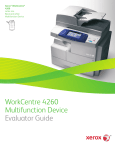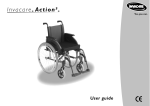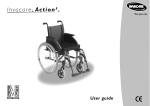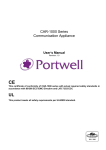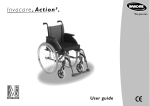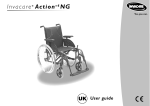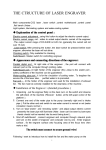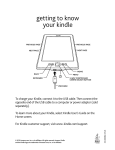Download Invacare Action 1 NG
Transcript
Invacare® Action® 1 NG Range MAINTENANCE A N D ADJUSTMENT Ac t i o n 1 N G R a n g e 1 December 2010 TABLE OF CONTENTS TABLE OF CONTENTS SECTION 1—TROUBLESHOOTING A N D M A I N T E N A N C E ........................................ ..4 Troubleshooting .................................................................................................................... ..4 Maintenance Guidelines & Safety Inspection..................................................................... ..4 Tightened Torques .............................................................................................................. ..7 Suggested Maintenance Procedures ................................................................................ ..7 Stability Warning .................................................................................................................. ..8 SECTION 2—FRONT HANGERS ............................................................................................ ..9 Adjusting Footrest Height .................................................................................................... ...9 Replacing Heel Strap ........................................................................................................... .10 Adjusting the Legrest Angle ................................................................................................. .10 Adjusting the Footplate Height ........................................................................................... .10 Adjusting Calfpad Height ..................................................................................................... .11 Adjusting Calfpad Depth ...................................................................................................... .11 SECTION 3—ARMRESTS ........................................................................................................ .12 Removing/Installing Swing Away Armrest ................................................................................12 Replacing Armrest Arm Pad ....................................................................................................13 SECTION 4—SEAT/BACK ............................................................................................................14 Removing Back Canes ............................................................................................................14 Removing/Installing Seat Upholstery .......................................................................................14 Removing/Installing Standard Back Upholstery ......................................................................15 Installing/Removing Seat Lap Belt ...........................................................................................16 Installing/Removing the Back Brace ........................................................................................17 SECTION 5—REAR WHEELS/FRONT CASTERS ......................................................................18 Removing/Installing Rear Wheels ...........................................................................................19 Quick-Release Axles ................................................................................................................19 Adjusting Quick-Release Axles ................................................................................................20 Replacing Handrims .................................................................................................................20 Adjusting Rear Wheel Height ...................................................................................................21 Replacing/Repairing Rear Wheel Tyre/Tube ...........................................................................21 Replacing/Repairing Front Caster Tyre/Tube ..........................................................................21 Removing/Installing/Repositioning the Castor Assemblies .....................................................22 Ac t i o n 1 N G R a n g e 2 TABLE OF CONTENTS SECTION 6—SEAT-TO-FLOOR H E I G H T ……………………………………………………23 Seat Angle ...............................................................................................................................23 Measuring Seat-to-Floor Height ............................................................................................24 Changing Seat-to-Floor Height ..............................................................................................25 SECTION 7—WHEEL BRAKES ............................................................................................26 Adjusting Wheel Brakes .........................................................................................................27 Replacing Wheel Lock Handle ...............................................................................................27 SECTION 8 — A N T I - T I P P E R S ..........................................................................................28 Installing/Adjusting Anti-Tippers ............................................................................................29 3 Ac t i o n 1 N G R a n g e SECTION 1—MAINTENANCE GUIDELINES SECTION 1—TROUBLESHOOTING A N D MAINTEN A N CE GUIDELINES NOTE: Twice a year, take your wheelchair to a qualified dealer for a thorough inspection and servicing. Regular cleaning will reveal loose or worn parts and enhance the smooth operation of your wheelchair. To operate properly and safely, your wheelchair must be cared for just like any other vehicle. Routine maintenance will extend the life and efficiency of your wheelchair. Initially and at least every twelve months, follow these maintenance procedures: Troubleshooting If pneumatic tyres, check for correct equal pressure. Check for loose stem nuts/screws. Check castor angle adjustment. Check that castor contact ground at the same time. Maintenance guide lines: Safety Inspection Checklists Initial adjustments should be made to suit the personal body structure needs and preferences of the user. Thereafter follow these maintenance procedures: Inspect/Adjust Initially (User or Attendant) Wheelchair rolls straight (no excessive drag or pull to one side). Ensure all hardware is tight (see page 7). All fasteners on clothing guards are secure. Arms are secure but easy to release and locking systems engage properly. Adjustable height arms operate and lock securely. Armrest arm pad sits flush against arm tube. Seat and/or back upholstery have no rips. Inspect adjustable angle back attaching hardware is securely tightened. Ensure hand grips are secure to backrest canes. Sealed bearings and axle nut tension are correct. No excessive side movement or binding when rear wheels are lifted and spun. Ac t i o n 1 N G R a n g e 4 SECTION 1— MAINTENANCE GUIDELINES Inspect/Adjust Initially (user or attendant) Quick-release axles lock properly (see page 19). Inspect handrims for signs of rough edges or peeling finish. Inspect for broken spokes. Wheel/fork assembly has proper tension when castor is spun. Castor should come to a gradual stop. Wheel bearings are clean and free of moisture. Loosen/tighten locknut if wheel wobbles noticeably or binds to a stop Ensure all castor/wheel/fork/head tube fasteners are secure (see pages 7 & 22). Wheel brakes do not interfere with tyres when rolling. Wheel brakes pivot point are free of wear and looseness. Wheel brakes are easy to engage. Inspect tyres/castors for flat spots and wear. Check pneumatic tyres for proper inflation (recommended tyre pressure is listed on the side wall of the tyre). Clean quick-release axles with a Teflon® lubricant. Ensure axles are free from dirt, lint, etc. Ensure roller bearings are free from dirt, lint, etc. Adjust wheel brakes as tires wear. Clean and wax all parts. Clean upholstery and armrests. Ensure castors are free of debris. Inspect/Adjust Weekly (User or Attendant) Wheelchair rolls straight (no excessive drag or pull to one side). Quick-release axles lock properly (see page 19). Inspect for broken spokes. Wheel/fork assembly has proper tension when castor is spun. Castor should come to a gradual stop. Inspect tyres/castors for flat spots and wear. Check pneumatic tyres for proper inflation (recommended tyre pressure is listed on the side wall of the tyre). Ensure castors are free of debris. Inspect/Adjust Monthly (User or Attendant) Inspect seat positioning strap for any signs of wear. Ensure buckle latches. Verify hardware that attaches strap to frame is secure and undamaged. Replace if necessary. Loosen/tighten locknut if wheel wobbles noticeably or binds to a stop. 5 Ac t i o n 1 N G R a n g e SECTION 1—MAINTENANCE GUIDELINES Inspect/Adjust Monthly (User or Attendant) Wheel bearings are clean and free of moisture. Wheel brakes do not interfere with tyres when rolling. Wheel brake pivot point are free of wear and looseness. Ensure all castor/wheel/fork/head tube fasteners are secure (see pages 7 & 22). Ensure all hardware is tight (see page 7). Ensure hand grips are secure to backrest canes. Ensure castors are free of debris. Inspect/Adjust every twelve months (Repairer or Dealer) Wheelchair rolls straight (no excessive drag or pull to one side). Arms are secure but easy to release and locking systems engage properly. Adjustable height arms operate and lock securely. Armrest arm pad sits flush against arm tube. All fasteners on clothing guards are secure. Seat and/or back upholstery have no rips. Inspect adjustable angle back attaching hardware is securely tightened. No excessive side movement or binding when rear wheels are lifted and spun. Inspect handrims for signs of rough edges or peeling finish. Inspect tyres/castors for flat spots and wear. Check pneumatic tyres for proper inflation (recommended tyre pressure is listed on the side wall of the tyre). Wheel brake pivot point are free of wear and looseness. Clean upholstery and armrests. Sealed bearings and axle nut tension are correct. Wheel/fork assembly has proper tension when castor is spun. Castor should come to a gradual stop. Loosen/tighten locknut if wheel wobbles noticeably or binds to a stop. Wheel bearings are clean and free of moisture. Wheel brakes are easy to engage. Clean quick-release axles with a Teflon lubricant. Ensure axles are free from dirt, lint, etc. Ensure roller bearings are free from dirt, lint, etc. Adjust wheel brakes as tyres wear. Clean and wax all parts. Ensure castors are free of debris. Ac t i o n 1 N G R a n g e 6 SECTION 1— MAINTENANCE GUIDELINES WARNING After ANY adjustments, repair or service and before use, make sure all attaching hardware is tightened securely - otherwise injury or damage may occur. CAUTION DO NOT over tighten hardware attaching to the frame. This could cause damage to the frame tubing. Tightening torques The tightening torques stated in the following table are dependent on the thread diameters for the nuts and bolts for which no special values are determined. All values apply to dry and grease-free threads. Thread M4 M5 M6 M8 M10 Tightening torque 3 Nm 6 Nm 10 Nm 25 Nm 49 Nm in Nm maximum Caution: All other nuts not noted here must be tightened FINGERTIGHT ! Suggested Maintenance Procedures 1. Before using your wheelchair, make sure all nuts and bolts are tight. Check all parts for damage or wear and replace. Check all parts for proper adjustment. 2. Keep quick release axles free of dirt and lint to ensure positive locking and proper operation. Refer to Adjusting Quick Release Axles on section 5. WARNING DO NOT use WD-40, 3-in- 1 oil, or other penetrating lubricants on quick-release axles. Otherwise, binding and/or damage to the wheelchair may occur. 3. Clean quick release axles once a week with a Teflon lubricant. WARNING DO NOT use your wheelchair unless it has the proper tyre pressure (BAR, KPa or P.S.I.). DO NOT over inflate the tyres. Failure to follow these suggestions may cause the tyre to explode and cause bodily harm. The recommended tyre pressure is on the sidewall of the tyre. 4. Recommended tyre pressure is listed on the sidewall of the tyre (BAR, KPa or P.S.I.). CAUTION As with any vehicle, the wheels and tires should be checked periodically for cracks and wear, and should be replaced if damaged. 5. The wheels, castors and tyres should be checked periodically for cracks and wear, and should be replaced when necessary. 7 Ac t i o n 1 N G R a n g e SECTION 1— MAINTENANCE GUIDELINES & STABILITY WARNING 6. Regularly check for loose spokes in the rear wheels. If loose, have them adjusted. 7. Periodically check handrims to ensure they are secured to the rear wheels. Refer to Replacing Handrims on section 5. 8. Periodically check castor wheel bearings to make sure they are clean and free from moisture. Use a Teflon® lubricant if necessary. 9. Check upholstery for sagging, rips or tears. 10. Clean upholstery with mild soap and water. Stability Warning The seat height, seat depth, back angle, seating system/upholstery, size/position of the rear wheels, size/position of the front castors, seating options (e.g. headrest, back bag, …) as well as the user condition directly relate to the stability of the wheelchair. Any change to one or any combination of the nine may cause the wheelchair to increase/decrease in stability. CASTOR SIZE CASTOR POSITION Seat-to-floor heights have specific positions depending on rear wheel size, rear wheel position, front caster size/position and seat-to-floor angle. These adjustments MUST be performed by a qualified technician. Refer to sections 5 & 6. Ac t i o n 1 N G R a n g e 8 SECTION 2—FRONT HANGERS SECTION 2—FRONT HANGERS WARNING After ANY adjustments, repair or service and before use, make sure all attaching hardware is tightened securely - otherwise injury or damage may occur. A 5 cm clearance between the bottom of the footplate and the ground/floor MUST be maintained at all times. Adjusting Footrest Height NOTE: For this procedure, refer to FIGURE 2.1. 1. Remove calf strap, if so equipped. 2. Unscrew locking bolt (5 mm Allen key & 10 mm spanner) 3. Position the footrest assembly to the desired height. NOTE: A 5 cm clearance between the bottom of the footplate and the ground/floor MUST be maintained at all times. 4. If the distance between the bottom of footplate and the ground/floor is not 5 cm minimum, adjust footrest tube accordingly. 5. Using the locking bolt, secure the footrest tube to the footrest support. Securely tighten. 6. If necessary, repeat STEPS 2-5 to adjust remaining footrest. 7. Reinstall the calf strap, if so equipped. Locking bolt 5 cm mini FIGURE 2.1 Adjusting Footrest Height 9 Ac t i o n 1 N G R a n g e SECTION 2—FRONT HANGERS Replacing Heel Strap NOTE: For this procedure, refer to FIGURE 2.2. 1. Remove the locking bolt (5 mm Allen key & 10 mm spanner) that secure the footrest tube to the footrest support. 2. Remove the lower footrest assembly. 3. Remove the nut and strap screw that secure the heel strap to the footplate. 4. Slide heel strap over footrest tube. NOTE: When securing the heel strap to the Locking bolt footrest assembly, tighten the nut and strap screw until they are secure. Strap pin 5. Using the nut and strap screw, secure the Heel strap heel strap to the footplate. 6. Using the locking bolt, secure the Mounting screw footrest tube to the footrest support. FIGURE 2.2 Replacing Hell Strap Adjusting Elevating Legrest Angle, Height and Calf pad Height/Depth NOTE: For this procedure, refer to FIGURE 2.3. Adjusting the Legrest Angle 1. Loosen locking knob securing the rotating axle of the elevating legrest. 2. Adjust to the preset angle, release the indexer lever. 3. If necessary, repeat STEPS 1-2 to adjust remaining elevating legrest angle. Adjusting the Footplate Height 1. Loosen locking screw securing the slide tube to the elevating legrest. 2. Reposition footplate to desired height, securely tighten locking screw. 3. If necessary, repeat STEPS 1-2 to adjust remaining footplate height. Ac t i o n 1 N G R a n g e 10 SECTION 2—FRONT HANGERS Adjusting Calf pad Height 1. Loosen the locking button that secure the calf pad bracket to the elevating legrest assembly. 2. Slide the calf pad bracket up or down until the desired calf pad height is obtained. 3. Tighten the locking button securing the calf pad bracket to the elevating legrest assembly. If necessary, repeat STEPS 1-3 to adjust remaining calf pad Adjusting Calf pad Depth 1. Remove the mounting set that secure the calf pad to the calf pad bracket. 2. Insert mounting set through one of four calf pad bracket mounting holes. 3. Using the mounting set secure the calf pad to the calf pad bracket. 4. If necessary, repeat STEPS 1-3 to adjust remaining calf pad assembly. Indexer lever Calf pad Locking Button Mounting Set Locking Screw FIGURE 2.3 Adjusting Elevating Legrest Height and Calf pad Height/Depth 11 Ac t i o n 1 N G R a n g e SECTION 3—ARMRESTS Removing/Installing Swing Away Armrests Removing/Installing Swing Away Armrest NOTE: For this procedure, refer to FIGURE 3.1. Removing Swing Away Armrest 1. Unlock existing armrest assembly by operate the release lever. 2. Swing back on the existing armrest to remove from the front arm socket. 3. Push on the rear locking pin to remove it from the rear pivot socket. 4. Repeat STEPS 1-3 for opposite side of wheelchair, if necessary. Installing Swing Away Armrest 1. If necessary, remove existing armrest assembly as describe above. 2. Install new/existing armrest assembly, first into the rear pivot socket and into the front arm socket. 3. Lock new/existing armrest assembly by operate the release lever. Make sure that the dog point is properly engaged in its housing. 4. Repeat STEPS 1-3 for opposite side, if necessary. Release lever Dog point Rear pivot socket Front arm socket FIGURE 3.1 Removing/Installing Swing Away Armrest Ac t i o n 1 N G R a n g e 12 SECTION 3—ARMRESTS Replacing Armrest Arm pad NOTE: For this procedure, refer to FIGURE 3.2. 1. Remove the mounting screws that secure the arm pad to the armrest assembly. 2. Replace arm pad and securely tighten with the existing mounting screws. 3. Repeat STEPS 1-2 for the opposite side if necessary. Arm pad Armrest assembly Mounting screws FIGURE 3.2 Replacing Armrest Arm Pad 13 Ac t i o n 1 N G R a n g e SECTION 4—SEAT/BACK SECTION 4—SEAT/BACK WARNING The seat height, seat depth, back angle, seating system, size/position of the rear wheels, size/position of the front castors, seating options (e.g. headrest, back bag, …) as well as the user condition directly relate to the stability of the wheelchair. Any change to one or any combination of the nine may cause the wheelchair to decrease in stability. Refer to table on page 8. After ANY adjustments, repair or service and BEFORE use, make sure all attaching hardware is tightened securely - otherwise injury or damage may occur. Removing Back Canes NOTE: For this procedure, refer to FIGURE 4.1. 1. Remove the mounting screw and locknut that secures the back cane to the back cane bracket and the rear wheel support. 2. Repeat STEP 1 for the other back cane. 3. Remove the back canes out of the back cane brackets. Upholstery Back Cane bracket Back Cane Mounting screw Locknut FIGURE 4.1 Removing Back Canes Removing/Installing Seat Upholstery NOTE: For this procedure, refer to FIGURE 4.2 on page 12. Removi ng S eat Upholstery NOTE: To install the seat upholstery, reverse this procedure. Ac t i o n 1 N G R a n g e 14 SECTION 4—SEAT/BACK 1. Remove the height mounting screws and washers that secure the existing seat upholstery to the cross braces. 2. Remove the existing seat upholstery from the cross braces. 3. Install new seat upholstery by reversing STEPS 1-2. FIGURE 4.2 Removing/Installing Seat Upholstery Removing/Installing Standard Back Upholstery NOTE: For this procedure, refer to FIGURE 4.3. Removing Back Upholstery NOTE: To Install the Back Upholstery, reverse this procedure. 1. Remove the back canes. Refer to Removing Back Canes paragraph. 2. Remove the mounting screw that secures the back upholstery to the back canes. Refer to Detail “A”. 3. Remove the back upholstery from the back canes. Refer to Detail “B”. DETAIL “A” DETAIL “B” Upholstery Back Cane FIGURE 4.3 Removing/Installing Standard Back Upholstery 15 Ac t i o n 1 N G R a n g e SECTION 4—SEAT/BACK Installing/Removing Seat Lap Belt NOTE: For this procedure, refer to FIGURE 4.5. 1. Remove seat cushion from wheelchair, if necessary. 2. Remove the mounting screws and washers that secures the seat lap belt half to the backrest cane. 3. Repeat STEP 2 for opposite side, if necessary. 4. Do one of the following: • To install the seat lap belt, proceed to STEP 6. • Remove the existing seat lap belt from the wheelchair. 5. Engage the two halves of the new seat lap belt. 6. Align the mounting holes on the wheelchair frame and one end of the new seat lap belt. 7. Secure the new seat lap belt to the backrest cane with one mounting screw and washer. Tighten securely. 8. Repeat STEPS 6 and 7 for the opposite side of the seat lap belt. 9. Reinstall seat cushion onto wheelchair, if necessary. Seat lap belt Half Seat lap belt Half Backrest cane Mounting screw Mounting screw NOTE: Backrest upholstery removed for clarity. FIGURE 4.5 Installing/Removing Seat Lap Belt Ac t i o n 1 N G R a n g e 16 SECTION 4—SEAT/BACK Installing/Removing the Back Brace WARNING If a back brace is already installed, you don’t have to re-install the back cane inserts. After ANY adjustments, repair or service and before use, make sure all attaching hardware is tightened securely - otherwise injury or damage may occur. NOTE: For this procedure, refer to FIGURE 4.6. NOTE: To remove the back brace, reverse this procedure. 1. 2. 3. 4. 5. 6. 7. Remove the end caps from the back canes. Remove the handles from the back canes. Install the inserts into the back canes. Secure the inserts with mounting screws. Install the handles on the back canes. Align the back brace ends with the handles of the back canes. Secure the back brace to the back canes with the mounting bolts. Back brace FIGURE 4.6 Installing/Removing the Back Brace 17 Ac t i o n 1 N G R a n g e SECTION 5—REAR WHEELS/FRONT CASTORS SECTION 5—REAR WHEELS/FRONT CASTORS WARNING The seat height, seat depth, back angle, seating system, size/position of the rear wheels, size/position of the front casters, seating options (e.g. headrest, back bag, …) as well as the user condition directly relate to the stability of the wheelchair. Any change to one or any combination of the nine may cause the wheelchair to decrease in stability. These adjustments MUST be performed by a qualified technician. After ANY adjustments, repair or service and before use, make sure all attaching hardware is tightened securely - otherwise injury or damage may occur. Removing/Installing Rear Wheels WARNING If changing the size of the rear wheel or the seat-to-floor height, this procedure must be performed by a qualified technician. Fixed Axles, Transit version only NOTE: For this procedure, refer to FIGURE 5.1. Removing 1. Remove the fixed axle, washer and locknut that secure rear wheel to the axle bracket. 2. Remove existing rear wheel from the wheelchair. 3. Install new/existing rear wheel onto wheelchair. Refer to Removing/Installing Rear Wheels paragraph. Installing 1. Install fixed axle through washer, new/existing rear wheel and axle bracket. 2. Securely tighten with the existing locknut. Torque to 25 Nm. 3. If necessary, repeat STEPS 1-2 for opposite rear wheel. Ac t i o n 1 N G R a n g e 18 SECTION 5—REAR WHEELS/FRONT CASTORS Quick-Release Axles NOTE: For this procedure, refer to FIGURE 5.2. Removing 1. Hold the centre of the rear wheel and push in the tip of the quick release axle. 2. Pull the quick release axle and rear wheel out of the axle bracket on the wheelchair frame. 3. Push in the tip of the quick release axle again and pull the quick release axle out of the existing rear wheel. 4. Install new/existing rear wheel onto wheelchair. Refer to Removing/Installing Rear Wheels paragraph. WARNING Make sure the detent pin and locking pins of the quick-release axle are fully released before operating the wheelchair. The locking pins MUST be protruding past the inside of rear wheel hub for a positive lock. Keep locking pins clean. Always make sure that the spacer is in place. Invacare recommends inserting quick-release axles with the head end to the inside of the wheelchair to prevent accidental release during contact leisure activities. Installing Rear wheel 1. Install the existing quick-release axle through the new/existing rear wheel. Wheelchair frame 2. Install the new/existing rear wheel and quick-release axle into the axle bracket on the wheelchair frame. 3. Always make sure that the spacer is in place 4. Refer to Adjusting Quick-Release Axles paragraph if the locking pins are not protruding past the inside of the axle bushing or there is too much movement of the rear wheel assembly in a back and forth position. Spacer Quick-Release Axle FIGURE 5.2 Removing/Installing Rear Wheels 19 Ac t i o n 1 N G R a n g e SECTION 5—REAR WHEELS/FRONT CASTORS Adjusting Quick-Release Axles NOTE: For this procedure, refer to FIGURE 5.3. 1. Remove rear wheel and quick-release axle from the wheelchair. Refer to Removing/Installing Rear Wheels paragraph. 2. Depress detent pin in the quick-release axle and slide the quick-release axle through the rear wheel hub. 3. Release detent pin to ensure that the locking pins are fully released. 4. Increase or decrease end play by adjusting the locknut on the end of the quick release axle. Wheelchair Frame WARNING Locknut Make sure the detent pin of the quick-release axle is fully released BEFORE operating the wheelchair. Keep locking pins clean. Always make sure that the spacer is in place. 5. Reinstall rear wheel onto the wheelchair. Refer to Removing/Installing Rear Wheels paragraph. Spacer 6. Repeat STEPS 4-5 until the quickrelease axle detent pins are fully released past the wheelchair frame. Quick-Release Axle FIGURE 5.3 Adjusting Quick-Release Axles Replacing Handrims NOTE: for this procedure, refer to FIGURE 5.4. 1. Remove the rear wheel from the wheelchair. Refer to Removing/Installing Rear Wheels paragraph. 2. Remove the mounting screws that secure the existing handrim to the rear wheel. 3. Remove the existing handrim. 4. Install the new handrim and secure to the rear wheel with the existing mounting screws. Rear Wheel 5. Reinstall the rear wheel to the wheelchair. Refer to Removing/Installing Rear Wheels paragraph. Handrim 6. Repeat STEPS 1~5 for opposite wheel, if necessary. FIGURE 5.4 Replacing Handrims Ac t i o n 1 N G R a n g e 20 SECTION 5—REAR WHEELS/FRONT CASTORS Adjusting Rear Wheel Height NOTE: For this procedure, refer to FIGURE 5.5. 1. Remove the rear wheel. Refer to Removing/Installing Rear Wheels paragraph. 2. Install the rear wheel to the other position. Refer to Removing/Installing Rear Wheels paragraph. 3. Repeat STEPS 1 to 2 for the other rear wheel. NOTE: Both rear wheels should be set at the same height position. Rear Wheel Positions Wheelchair Frame FIGURE 5.5 Adjusting Rear Wheel Height Replacing/Repairing Rear Wheel Tyre/Tube WARNING Replacement of rear wheel tyre or tube MUST be performed by a qualified technician. Replacing/Repairing Front Castor Tyre/Tube WARNING Replacement of front castor tyre or tube MUST be performed by a qualified technician. CAUTION As with any vehicle, the wheels and tires should be checked periodically for cracks and wear, and should be replaced when necessary. 21 Ac t i o n 1 N G R a n g e SECTION 5—REAR WHEELS/FRONT CASTORS Removing/Installing/Repositioning the Castor Assemblies NOTE: If replacing a front castor note the mounting position of the existing front castor for installation of the new front castor. NOTE: If repositioning front castors or replacing the existing front caster with a castor of a different size, refer to Changing Front Seat-to-Floor Height paragraph to determine the front castor position needed for the required front seat-to-floor height. NOTE: Both front castors MUST be the same size and adjusted to the same height. NOTE: For this procedure, refer to FIGURE 5.6. Removing Front Wheel 1. Remove the mounting bolt and locknut that secure the front wheel to the fork. 2. Remove the wheel from the fork. Front Fork Installing Front Wheel 1. Using the mounting bolt and locknut, secure the wheel to the desired wheel mounting position. 2. Ensure fork stem is perpendicular to the flat surface. Refer to Adjusting Castor Angle paragraph. Locknut Mounting Bolt Wheel FIGURE 5.6 Removing/Installing/Repositioning the front wheel Action1 NG Range 22 SECTION 6—SEAT-TO-FLOOR HEIGHT SECTION 6—SEAT-TO-FLOOR HEIGHT WARNING After ANY adjustments, repair or service and before use, make sure all attaching hardware is tightened securely - otherwise injury or damage may occur. Seat Angle NOTE: For this procedure, refer to FIGURE 6.1. NOTE: Refer to Measuring Seat-to-Floor Height paragraph for measuring instructions. NOTE: Invacare recommends that the rear seat-to-floor height be AT LEAST 2,5 cm shorter than the front seat-to-floor height. Otherwise a forward seat angle can occur. Subtract the rear seat-to-floor height measurement from the front seat-to-floor height measurement to determine the amount of seat angle as shown in the example in FIGURE 6.1. Seat Depth = 42.5 cm Front Seat-to-Floor Height Rear Seat-to-Floor Height Ex am p le : 50 cm Front Seat-to-Floor Height - 47,5 cm Minus Rear Seat-to-Floor Height (3° +/-1° ) Equals Seat Angle FIGURE 6.1 Seat Angle WARNING Because of the parts mechanical tolerances and all adjustments possible (+/- 1°) the seat angles possible is 3° +/-1° depending of the wheelchair assembly. Refer to table “Seat-to-floor heights” paragraph. 23 Ac t i o n 1 N G R a n g e SECTION 6—SEAT-TO-FLOOR HEIGHT Measuring Seat-to-Floor Height NOTE: For this procedure, refer to FIGURE 6.2. NOTE: All measurements are in centimetres. The front and rear seat-to-floor heights are approximate to 0,65 cm due to tyre wear and air pressure. Measuring Front Seat-to-Floor Height Front Seat-to-Floor Height: Measure the distance between the front of the seat upholstery and the ground/floor. Measuring Rear Seat-to-Floor Height NOTE: The rear seat-to-floor heights are based on pneumatic tyres and pneumatic tyres with flat free inserts. If wheelchair is equipped with urethane tyres, subtract 0,65 cm from the measurement. Rear Seat-to-Floor Height: Measure distance between the rear of the seat upholstery and the ground/floor. Seat upholstery Front Seat-to-Floor Height Rear Seat-to-Floor Height FIGURE 6.2 Seat Angle Changing Seat-to-Floor Height WARNING The seat height, seat depth, back angle, seating system, size/position of the rear wheels, size/position of the front castors, seating options (e.g. headrest, back bag, …) as well as the user condition directly relate to the stability of the wheelchair. Any change to one or any combination of the nine may cause the wheelchair to decrease in stability. Refer table on page 8. Always check castor vertical axis is to 90° +/-1° from the ground. Ac t i o n 1 N G R a n g e 24 SECTION 6—SEAT-TO-FLOOR HEIGHT Changing Seat-to-Floor Height NOTE: For this procedure, refer to FIGURE 6.3. and the table to determine adjustment(s) necessary to achieve desired front seat to floor height. NOTE: In order to obtain the desired front seat to floor height, it will be necessary to perform one or both of the following: • • Changing the castor mounting position on the fork. Refer to Removing/Installing/Repositioning the Castor Assemblies paragraph. Changing the rear height positioning. Refer to Adjusting Rear Wheel Height paragraph. SEAT ANGLE 3° SEAT HEIGHT REAR WHEEL FRONT CASTOR 24” 8” 50 cm A A 45 cm B B A B FIGURE 6.3 Seat To Floor Height 25 Ac t i o n 1 N G R a n g e SECTION 7—WHEEL BRAKES SECTION 7—WHEEL BRAKES WARNING After ANY adjustments, repair or service and BEFORE use, make sure all attaching hardware is tightened securely - otherwise injury or damage may occur. Ensure that the clamp assembly is well positioned in its frame located position. Adjusting Wheel Brakes NOTE: When changing the position of the rear wheels, the wheel brakes MUST be repositioned. NOTE: Before adjusting or replacing the wheel brake assemblies, ensure that the tyres are inflated to the recommended BAR, KPa, P.S.I on the side wall of the tyre. NOTE: If wheel brakes need replacement, installation must be performed by a qualified technician. A d j u st i ng W h ee l B r a ke P o s i t i o n NOTE: For this procedure, refer to FIGURE 7.1. 1. Remove the two mounting screws that secures the wheel brake assembly to the wheelchair frame. 2. Remove the wheel brake assembly from the clamp assembly. 3. Move the clamp assembly (if necessary) to the other wheel brake position on the wheelchair frame. 4. Install the wheel brake assembly into the clamp assembly. 5. Secure the wheel brake assembly to the wheelchair frame with the two mounting screws. 6. Repeat STEPS 1 to 6 for the other wheel brake assembly. Frame Located Position Wheelchair Wheel Brake Frame FIGURE 7.1 Adjusting Wheel Brakes - Adjusting Wheel Brake Position Ac t i o n 1 N G R a n g e 26 SECTION 7—WHEEL BRAKES Adjusting Wheel Brake Tension NOTE: For this procedure, refer to FIGURE 7.2. 1. Loosen, but DO NOT remove the two set screws (Detail –A-) that secure the wheel brake assembly to the wheelchair frame. 2. Measure the distance between the wheel brake shoe and the rear wheel. 3. Slide the wheel lock along the wheelchair frame until the measurement is 0,6 cm for solid tyre and 0,5 cm for pneumatic. 4. Securely tighten the two set screws (Detail –A-). 5. Repeat STEPS 1-4 for the opposite wheel brake. 6. Engage the wheel brakes and push against the wheelchair to determine if the wheel brakes engage the rear wheels enough to hold the occupied wheelchair. 7. Repeat STEPS 1-6 until the wheel brakes engage the rear wheels enough to hold the occupied wheelchair. D E T AI L “ A” Measure This Distance Shoe Wheel Brake Assembly 3. Align FIGURE 7.2 Adjusting Wheel Brakes- Adjusting Wheel Brake Tension Replacing Wheel Brake Handle NOTE: For this procedure, refer to FIGURE 7.3. 1. Remove the mounting screw and locknut that secures the wheel brake handle to the wheel brake assembly. Handle 2. Remove the wheel brake handle and discard. 3. Align the new wheel brake handle with the wheel brake assembly. 4. Secure the new wheel brake handle with the mounting screw and locknut. 5. If necessary, repeat STEPS 1 to 4 for the other wheel brake. Mounting Screw Wheel Brake Locknut Wheel Brake Assembly FIGURE 7.3 Replacing Wheel Brake Handle 27 Ac t i o n 1 N G R a n g e SECTION 8—ANTI-TIPPERS SECTION 8—ANTI-TIPPERS WARNING After ANY adjustments, repair or service and BEFORE use, make sure all attaching hardware is tightened securely - otherwise injury or damage may occur. Anti-tippers MUST be attached at all times. Inasmuch as the anti-tippers are an option on this wheelchair (you may order it with or without the anti-tippers), Invacare strongly recommends ordering the anti-tippers as an additional safeguard for the wheelchair user. Anti-tippers MUST be fully engaged and release buttons fully protruding out of adjustment holes. Ensure both anti-tippers are adjusted to the same mounting hole. Installing/Adjusting Anti-Tippers Installing Anti-Tippers NOTE: For this procedure, refer to FIGURE 8.1. 1. Press release buttons in and insert anti-tippers with the anti-tipper wheels pointing toward ground/floor into the rear frame tubing until bottom release button locks in place. 2. Measure the distance between the bottom of the anti-tipper wheels and the ground/floor. Fixed Axle NOTE: A 3 to 5 cm clearance between the bottom of the anti-tipper wheels and the ground/floor MUST be maintained at all times. 3. If the distance between the bottom of anti-tipper wheels and the ground/floor is not 3 to 5 cm, adjust anti-tippers. FIGURE 8.1 Installing Anti-Tippers Ac t i o n 1 N G R a n g e 28 SECTION 8—ANTI-TIPPERS Adjusting Anti-Tippers NOTE: For this procedure, refer to FIGURE 8.2. WARNING When anti-tippers are used, anti-tippers MUST be adjusted to maintain a 3 to 5 cm clearance between the bottom of the anti-tipper wheels and the ground/ floor. This spacing should always be checked whenever adjustments/changes are made to the wheelchair. Make sure that the anti-tipper wheel is ALWAYS located out side the rear wheel volume. Failure to maintain proper spacing may result in the chair tipping over backward causing serious injury or property damage 1. Press the release buttons on the wheeled portion of the anti-tipper and slide it up or down to achieve the 3 to 5 cm clearance. 2. Check to make sure that the release buttons are fully engaged in adjustment holes. NOTE: Make sure that the anti-tipper wheel is ALWAYS located out side the rear wheel volume. Anti-tipper wheel 3FIGURE to 5 cm 8.2 Adjusting Anti-Tippers FIGURE 8.2 Adjusting Anti-Tippers 29 Ac t i o n 1 N G R a n g e Invacare France Operations Route de St Roch 37230 Fondettes FRANCE AC1NG-MM-01UK V1 12-2010

































